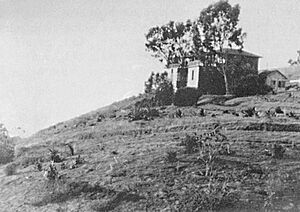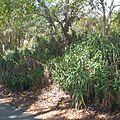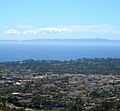Franceschi Park facts for kids
Quick facts for kids Franceschi Park |
|
|---|---|

Franceschi Park in Santa Barbara
|
|
| Location | 1510 Mission Ridge Road in Santa Barbara, California. |
| Area | 15.78-acre (6.39 ha) |
| Created | Major portion June 1931; small additions 1962, 1964, and 1976 |
| Operated by | City of Santa Barbara Parks & Recreation Department |
| Website | Franceschi Park |
Franceschi Park is a beautiful public park in Santa Barbara, California. It covers about 15.78 acres (6.39 hectares). The park is located high up on Mission Ridge Road, about 800 feet (244 meters) above the ocean. From here, you can see amazing views of Santa Barbara's coastline and the Channel Islands.
The park is split into two parts by Mission Ridge Road. The upper part is larger, about 10.94 acres (4.43 hectares). The lower part is about 4.84 acres (1.96 hectares). Franceschi Park has picnic areas, restrooms, walking trails, and a parking lot. It also honors the important plant work done by an Italian plant expert named Dr. Francesco Franceschi.
Contents
Park History and Its Namesake
The park is named after Dr. Francesco Franceschi (1843-1924). He was a famous plant expert from Italy. From 1903 to 1913, Dr. Franceschi used 40 acres (16 hectares) of this land. He created a special botanical garden and a plant nursery here.
When his wife, Christina, bought the land, it was mostly empty with many rocks. But Dr. Franceschi thought it was perfect for a botanical garden. The land had different slopes, which meant some parts got more sun than others. The soil was also very rich and held water well.
The park officially opened in 1931. Over the years, small pieces of land were added to the park. For example, in 1976, a developer donated a small piece of land. This helped improve the views from the park.
The Montarioso Mansion: A Historic Home
In 1905, a large house was built on the property. It was made of redwood in the Craftsman style. Dr. Franceschi named it "Montarioso," which means "airy mountain." The house was made even bigger two years later.
After Dr. Franceschi and his wife moved back to Italy, parts of the property were sold. In 1927, a wealthy man named Alden Freeman bought the mansion and 2.14 acres of land. He admired Dr. Franceschi's work. Freeman decided to create a park to remember Franceschi. He bought back some of the original land and added more.
Freeman also changed the mansion. He made it into a large, four-story building in a Mediterranean style. This was to honor Dr. Franceschi's Italian background. He added terraces, stairs, and a fountain. Some of Dr. Franceschi's original garden features, like stone walls, were kept.
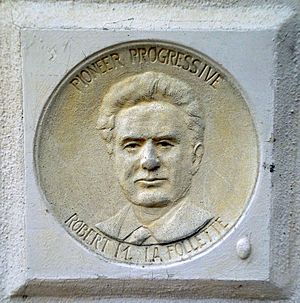
The outside walls of the mansion were decorated with 85 special medallions and plaques. These honored Dr. Franceschi, important historical events, and famous people. Some medallions remembered events from the American Revolution. Others honored people like Emily Dickinson (a poet) and William Penn (who founded Pennsylvania). There were also family crests and images of famous landmarks.
A copy of these medallions can be found on another house built by Alden Freeman in Florida. This house is now known as the Versace Mansion. When fashion designer Gianni Versace bought it, he made sure to restore these medallions.
In 1929, Freeman offered the mansion and the land to the City of Santa Barbara to become a park. The City was worried about paying for its upkeep. But a local group offered to pay for maintenance for two years. So, in 1931, the City accepted the offer. For a while, the house was used by the California State Guard and for teaching about plants.
By 1963, the house was in bad shape and was empty for many years. Some people wanted to tear it down. But a woman named Pearl Chase started a group to save it. Thanks to their efforts, the City Council decided in 1981 to call the Montarioso mansion a "City Structure of Merit." This means it's an important building to protect. Even though there have been talks about tearing it down again, the house is still standing today.
Dr. Franceschi's Botanical Garden and Nursery
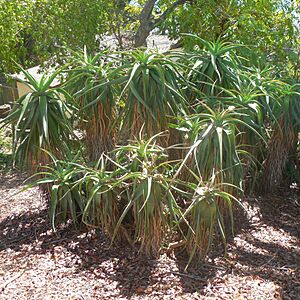
Dr. Franceschi planted many different kinds of plants on about ten acres of his property. He carefully placed them in areas that were best for them. He considered the sunlight, soil, and how much water they needed. He used a planting style that didn't need a lot of water, similar to modern water-saving gardens.
At the garden's entrance, there were two groups of dragon trees. He also grew an orchard of fruits and nuts. Water was pumped from a nearby reservoir to water the plants. He grew about one hundred types of palm trees from seeds. On the sunny, rocky slopes, he planted cactus, aloes, and agaves.
He also grew acacias and other Australian shrubs that didn't need much water. Under the shade of California live oak trees, he grew plants like camellia and rhododendron. He tried to have plants flowering all year round.
One important plant Dr. Franceschi introduced to California was called lippia (Phyla nodiflora). He brought it from the Botanical Garden of Rome in 1899. This plant became very popular as a replacement for grass lawns. It could grow in almost any soil and needed much less water than grass. It also grew quickly and didn't need mowing.
In 1908, Dr. Augustus Boyd Doremus, Santa Barbara's first park superintendent, planted Italian stone pine trees along East Anapamu Street. These trees were grown from seeds at Dr. Franceschi's nursery. Many of these pines are still there today.
By 1909, Dr. Franceschi wanted the City of Santa Barbara to turn his nursery into "The Santa Barbara Arboretum." He had 135 different kinds of plants growing there. The City didn't act on his idea. His nursery's catalog listed many plants, including palms, bamboo, fruit trees, and evergreen trees. The next year, he had even more varieties available.
In 1963, a plant expert named Will Beittel found that over fifty of the plant species Dr. Franceschi introduced were still growing in the park. This showed how important his work was.
Southern California Acclimatizing Association (SCAA)
Dr. Franceschi also started a plant business called the Southern California Acclimatizing Association (SCAA). It had locations in Santa Barbara. These places were both stores and research centers. They were known for growing and introducing many useful plants and fruits that could grow well in the local climate.
The SCAA started in 1893 with a partner named Charles Frederick Eaton. They grew seeds from all over the world to see if they could adapt to California's Mediterranean climate. This was the first nursery in California to scientifically test new plants for this purpose.
In 1907, Dr. Franceschi partnered with Peter Riedel, another plant expert. They worked on designing gardens for many Santa Barbara estates. They used their unique plants in these projects. However, their partnership ended in 1909. Dr. Franceschi then continued his nursery work from his Montarioso property. His daughter, Ernestina, and son, Cammillo, helped him.
Dr. Franceschi later moved back to Italy in 1913 to work for the Italian government. He and his wife started using their original family name, Fenzi, again. Ernestina later joined her parents in 1916.
Park Maintenance and Improvements
Franceschi Park is in an area that has a high risk of fires. Because of this, the park has a special plan to manage its plants. This involves trimming plants and clearing weeds. These efforts help prevent fires and keep the neighborhood safe.
The City Council approved a master plan for the park in 2004. This plan included ideas to make the park better for visitors and to protect its history. In 2007, the first improvements were completed. These included rebuilding the entry driveway, two paths, and the parking lot. Drainage was also improved. These projects were paid for with a $450,000 grant.
The lower part of the park is undeveloped and has several dirt trails. You can reach these trails from Mission Ridge Road, Dover Road, and Mira Vista Avenue.
Gallery


